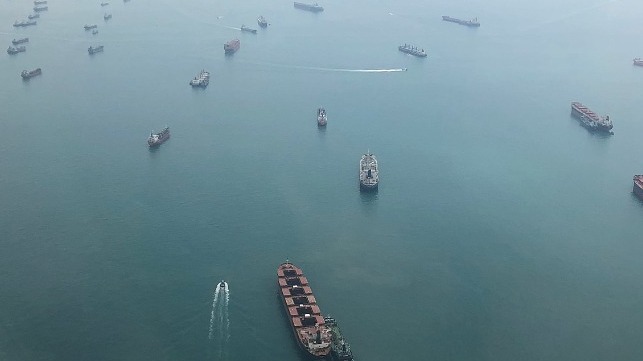COVID-19 Mitigation for the Maritime and Offshore Industries

The impact of the global Covid-19 pandemic has highlighted how marine and offshore assets can be affected by infectious disease risks just as readily as land-based facilities.
Where infectious disease risks occur, it is critical that robust arrangements, procedures and protocols be designed and implemented to help assure the health and wellbeing of seafarers and passengers, whilst maintaining day-to-day operations of marine and offshore assets.
In this article, Martin Petricic and Gareth Burton of ABS – one of the world’s leading providers of classification and technical advisory services to the marine and offshore industries – provide practical guidance and insights for the mitigation of infectious disease outbreak risks onboard. They collaborated with Rear Admiral Joyce Johnson DO MA U.S. Public Health Service (Ret'd), a physician and infectious disease epidemiologist with an expansive career of senior public health leadership in civilian and U.S. military sectors.
The ABS guidance includes both physical arrangements such as ventilation and interior surfaces of accommodation spaces, as well as operating procedures to allow isolation and segregation of crew and visiting personnel.
Infectious Disease Transmission
Many infectious diseases are caused by microbes including viruses, bacteria, fungi, and protozoa. Some infectious agents can remain viable in air, water, food, on surfaces, and in nearly all bodily fluids. Many infectious agents remain viable long enough to enable an indirect transfer from one person to another via one of these fomites, which can cause or increase an outbreak.
Given that the environment on marine and offshore assets is a restricted one, infectious diseases have the potential to spread rapidly and affect significant proportions of the personnel on board.
On marine and offshore assets, infectious diseases are transmitted through six main routes:
- Food
- Water
- Vectors (e.g., insects and rodents)
- Air – droplet or aerosol transmission
- Direct contact with an infected person
- Indirect contact with contaminated objects and surfaces
By considering the potential of infectious disease transmission at the design stage of an asset, the effectiveness of later operational measures can be significantly increased. In a recent poll conducted by ABS, approximately one third of participants said they are considering changing future marine or offshore asset design or altering current assets to better manage an outbreak on board.
For many existing assets however, without the option of re-design, the key is to develop protocols and procedures aimed at mitigating impact should an outbreak occur.
Regulatory Requirements and Current Standards
Numerous regulatory bodies have issued standards for general sanitary conditions. For example, the International Health Regulations governed by the World Health Organization. Such Standards offer effective requirements and best practices regarding food and water safety, vector control, and waste management.
However, following an extensive literature review and consultations with prominent medical experts, ABS has identified a lack of explicit technical guidance regarding physical arrangements and procedures to help make marine and offshore assets more resistant to the occurrence and transmission of infectious diseases such as Covid-19 whether they are spread via air or direct and indirect forms of contact.
Physical Arrangement Measures
Based on several independent governmental and commercial sources including the United States Centers for Disease Control and Prevention (CDC), American Society for Healthcare Engineering (ASHE), the International Organization for Standardization (ISO), and the World Health Organization (WHO), ABS has identified the following ways to mitigate against the occurrence and transmission of infectious diseases via air or direct and indirect forms of contact onboard a physical asset:
i) Single Occupancy Isolation Cabins with an anteroom provide a means for isolating individuals with suspected cases of an infectious disease from the rest of the population on board. Isolation cabins and their associated anterooms should be under negative pressure to prevent the contaminated air from escaping to neighboring accommodation spaces. They should also be ventilated and air-conditioned without putting the exhaust air back into recirculation or venting it near high-traffic public spaces or other air intakes. If it is not possible to feed the exhaust air directly to the outside, the exhaust air should first be passed through a high-efficiency particulate air (HEPA) filter before recirculation. Special consideration should be given to the sufficient number of isolation cabins and their location to minimize the possibility of inadvertent contact between the isolated suspected cases and the rest of the population on board. Another important aspect to consider is the choice of materials and the condition of surfaces inside the isolation cabins in order to facilitate easy cleaning and disinfection of these spaces.
ii) Medical Facilities should also be under negative pressure and be located as close as possible to the entrance into the accommodation block from an open deck space. Ventilation, material, and surface requirements like the ones for the isolation cabins should be considered.
iii) Facilities for use by Visitors should be considered in order to promote the segregation of visitors and crew. Designated sanitary and office spaces should be provided with independent air exhausts and interior material and surface requirements like the ones for isolation cabins. These spaces should be readily accessible from an outside entrance to avoid inadvertent contact between visitors and crew.
iv) Storerooms for infectious solid waste, storerooms for cleaning agents and disinfectants, and laundry rooms should be given careful consideration as well. These spaces should be well ventilated with the exhaust air fed directly to the outside. All interior surfaces should be accessible for cleaning and disinfection. Infectious solid waste should not be stored in direct sunlight. Therefore, any window in such space should be provided with a shade. Washing machines in the laundry room should be capable of reaching hot water temperature above 71°C (160°F).
v) Support infrastructure, to provide medical back-up and advice to physicians and other health care personnel should be considered. For example, telemedicine can contribute to clinical care, as well as to the epidemiological management of infectious diseases, both of which can be very challenging, especially for medical providers practicing in remote or isolated locations.
vi) Independent pilot ladders stored in a separate compartment or locker will minimize the possibility of pilot and crew coming into contact with the same surfaces.
Operational Measures
In addition to physical aspects of the vessel design, operational measures can have a significant impact on mitigation of infectious disease occurrence and transmission on board marine and offshore assets.
ABS recognizes that each infectious disease outbreak is unique, and may present different operational challenges. Further, the same objectives of early detection, prevention, and control of infectious diseases may be achieved using many different operational measures. Therefore, asset operators and owners are strongly advised to develop the following two types of operational plans and integrate them in their health, safety, quality and environmental (HSQE) management system.
i) Prevention Management Plan – this should include active measures to minimize the risk of exposure and should be implemented in case of an infectious disease epidemic in the area where the asset is located or will be in the near future, or in the case of a global pandemic, before the asset experiences cases.
The Prevention Management Plan should address the following mitigation measures:
- Surveillance of possible outbreaks
- Identification of high-risk areas for cleaning and disinfection
- Access control measures for visitors
- Personal hygiene and social distancing
- Separation of crew into different teams with shift staggering
- Staggering of meal services
- Limiting large gatherings and promoting remote communication methods
- Personnel rotations and shift change procedures
- Port call and liberty polices
- Provisioning of supplies, especially medical supplies, personal protective equipment, and cleaning agents and disinfectants;
- Crew training
ii) Outbreak Management Plan – To be implemented should exposure be suspected, the plan should contain a range of measures designed to help to manage the outbreak, addressing key measures including:
- Active surveillance for cases onboard
- Incident reporting procedures for informing the local Port Health Authority and Asset Management
- Locations for isolation of suspected cases
- Using telemedicine to care for the suspected case
- Management of communications between the suspected case and the crew and between different crew departments caring for the suspected case
- Clinical management of the suspected case
- Cleaning and disinfection procedures for spaces contaminated by the suspected case
- Management of contacts of the suspected case
- Collection of personal passenger information, visitors, and crew to facilitate contact tracing
- Management of food, waste collection, and laundry services provided to the suspected case
- Disembarkation protocols for the suspected case
- Provisioning of supplies, especially medical supplies, personal protective equipment, and cleaning agents and disinfectants
- Crew training.
Concluding Remarks
When looking at the potential for infectious disease outbreaks in marine and offshore assets, effective preparation, prevention and management protocols are critical to help mitigate the impact any outbreak could have. The combination of physical arrangement measures for each individual asset with robust and clearly communicated Prevention and Outbreak Management Plans are critical to enable preparedness should an outbreak occur.

Gareth Burton (left) is Vice President of Operational & Environmental Performance at American Bureau of Shipping.
Martin Petricic (center) is an engineer at American Bureau of Shipping.
Rear Admiral Joyce Johnson (right) is a professor at Georgetown University and former chief medical officer and surgeon general of the U.S. Coast Guard. She was the first woman to attain flag rank on active duty with the USCG.
The opinions expressed herein are the author's and not necessarily those of The Maritime Executive.

